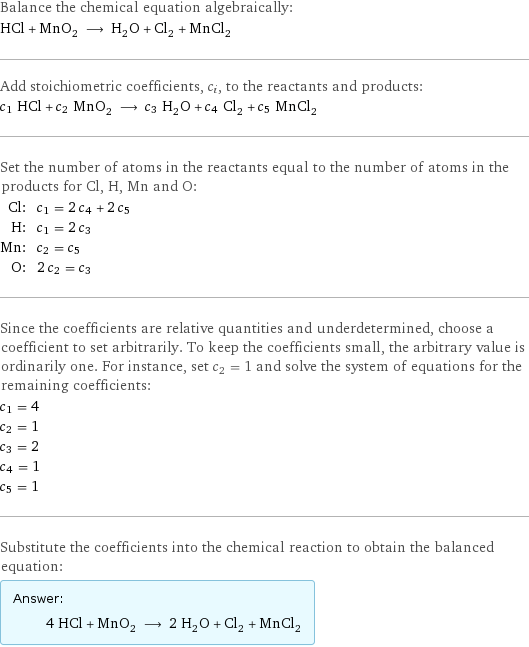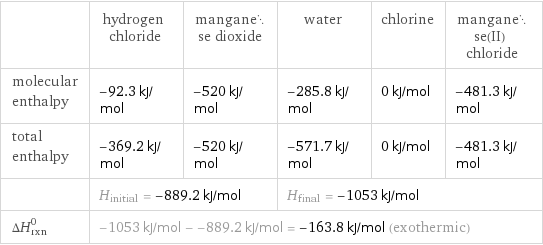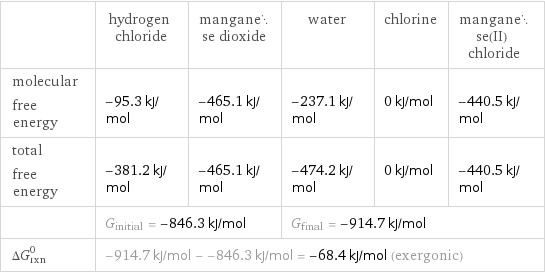Input interpretation

HCl (hydrogen chloride) + MnO_2 (manganese dioxide) ⟶ H_2O (water) + Cl_2 (chlorine) + MnCl_2 (manganese(II) chloride)
Balanced equation

Balance the chemical equation algebraically: HCl + MnO_2 ⟶ H_2O + Cl_2 + MnCl_2 Add stoichiometric coefficients, c_i, to the reactants and products: c_1 HCl + c_2 MnO_2 ⟶ c_3 H_2O + c_4 Cl_2 + c_5 MnCl_2 Set the number of atoms in the reactants equal to the number of atoms in the products for Cl, H, Mn and O: Cl: | c_1 = 2 c_4 + 2 c_5 H: | c_1 = 2 c_3 Mn: | c_2 = c_5 O: | 2 c_2 = c_3 Since the coefficients are relative quantities and underdetermined, choose a coefficient to set arbitrarily. To keep the coefficients small, the arbitrary value is ordinarily one. For instance, set c_2 = 1 and solve the system of equations for the remaining coefficients: c_1 = 4 c_2 = 1 c_3 = 2 c_4 = 1 c_5 = 1 Substitute the coefficients into the chemical reaction to obtain the balanced equation: Answer: | | 4 HCl + MnO_2 ⟶ 2 H_2O + Cl_2 + MnCl_2
Structures

+ ⟶ + +
Names

hydrogen chloride + manganese dioxide ⟶ water + chlorine + manganese(II) chloride
Reaction thermodynamics
Enthalpy

| hydrogen chloride | manganese dioxide | water | chlorine | manganese(II) chloride molecular enthalpy | -92.3 kJ/mol | -520 kJ/mol | -285.8 kJ/mol | 0 kJ/mol | -481.3 kJ/mol total enthalpy | -369.2 kJ/mol | -520 kJ/mol | -571.7 kJ/mol | 0 kJ/mol | -481.3 kJ/mol | H_initial = -889.2 kJ/mol | | H_final = -1053 kJ/mol | | ΔH_rxn^0 | -1053 kJ/mol - -889.2 kJ/mol = -163.8 kJ/mol (exothermic) | | | |
Gibbs free energy

| hydrogen chloride | manganese dioxide | water | chlorine | manganese(II) chloride molecular free energy | -95.3 kJ/mol | -465.1 kJ/mol | -237.1 kJ/mol | 0 kJ/mol | -440.5 kJ/mol total free energy | -381.2 kJ/mol | -465.1 kJ/mol | -474.2 kJ/mol | 0 kJ/mol | -440.5 kJ/mol | G_initial = -846.3 kJ/mol | | G_final = -914.7 kJ/mol | | ΔG_rxn^0 | -914.7 kJ/mol - -846.3 kJ/mol = -68.4 kJ/mol (exergonic) | | | |
Equilibrium constant
![Construct the equilibrium constant, K, expression for: HCl + MnO_2 ⟶ H_2O + Cl_2 + MnCl_2 Plan: • Balance the chemical equation. • Determine the stoichiometric numbers. • Assemble the activity expression for each chemical species. • Use the activity expressions to build the equilibrium constant expression. Write the balanced chemical equation: 4 HCl + MnO_2 ⟶ 2 H_2O + Cl_2 + MnCl_2 Assign stoichiometric numbers, ν_i, using the stoichiometric coefficients, c_i, from the balanced chemical equation in the following manner: ν_i = -c_i for reactants and ν_i = c_i for products: chemical species | c_i | ν_i HCl | 4 | -4 MnO_2 | 1 | -1 H_2O | 2 | 2 Cl_2 | 1 | 1 MnCl_2 | 1 | 1 Assemble the activity expressions accounting for the state of matter and ν_i: chemical species | c_i | ν_i | activity expression HCl | 4 | -4 | ([HCl])^(-4) MnO_2 | 1 | -1 | ([MnO2])^(-1) H_2O | 2 | 2 | ([H2O])^2 Cl_2 | 1 | 1 | [Cl2] MnCl_2 | 1 | 1 | [MnCl2] The equilibrium constant symbol in the concentration basis is: K_c Mulitply the activity expressions to arrive at the K_c expression: Answer: | | K_c = ([HCl])^(-4) ([MnO2])^(-1) ([H2O])^2 [Cl2] [MnCl2] = (([H2O])^2 [Cl2] [MnCl2])/(([HCl])^4 [MnO2])](../image_source/b5ee5a7720f0f271febab409b271e4b4.png)
Construct the equilibrium constant, K, expression for: HCl + MnO_2 ⟶ H_2O + Cl_2 + MnCl_2 Plan: • Balance the chemical equation. • Determine the stoichiometric numbers. • Assemble the activity expression for each chemical species. • Use the activity expressions to build the equilibrium constant expression. Write the balanced chemical equation: 4 HCl + MnO_2 ⟶ 2 H_2O + Cl_2 + MnCl_2 Assign stoichiometric numbers, ν_i, using the stoichiometric coefficients, c_i, from the balanced chemical equation in the following manner: ν_i = -c_i for reactants and ν_i = c_i for products: chemical species | c_i | ν_i HCl | 4 | -4 MnO_2 | 1 | -1 H_2O | 2 | 2 Cl_2 | 1 | 1 MnCl_2 | 1 | 1 Assemble the activity expressions accounting for the state of matter and ν_i: chemical species | c_i | ν_i | activity expression HCl | 4 | -4 | ([HCl])^(-4) MnO_2 | 1 | -1 | ([MnO2])^(-1) H_2O | 2 | 2 | ([H2O])^2 Cl_2 | 1 | 1 | [Cl2] MnCl_2 | 1 | 1 | [MnCl2] The equilibrium constant symbol in the concentration basis is: K_c Mulitply the activity expressions to arrive at the K_c expression: Answer: | | K_c = ([HCl])^(-4) ([MnO2])^(-1) ([H2O])^2 [Cl2] [MnCl2] = (([H2O])^2 [Cl2] [MnCl2])/(([HCl])^4 [MnO2])
Rate of reaction
![Construct the rate of reaction expression for: HCl + MnO_2 ⟶ H_2O + Cl_2 + MnCl_2 Plan: • Balance the chemical equation. • Determine the stoichiometric numbers. • Assemble the rate term for each chemical species. • Write the rate of reaction expression. Write the balanced chemical equation: 4 HCl + MnO_2 ⟶ 2 H_2O + Cl_2 + MnCl_2 Assign stoichiometric numbers, ν_i, using the stoichiometric coefficients, c_i, from the balanced chemical equation in the following manner: ν_i = -c_i for reactants and ν_i = c_i for products: chemical species | c_i | ν_i HCl | 4 | -4 MnO_2 | 1 | -1 H_2O | 2 | 2 Cl_2 | 1 | 1 MnCl_2 | 1 | 1 The rate term for each chemical species, B_i, is 1/ν_i(Δ[B_i])/(Δt) where [B_i] is the amount concentration and t is time: chemical species | c_i | ν_i | rate term HCl | 4 | -4 | -1/4 (Δ[HCl])/(Δt) MnO_2 | 1 | -1 | -(Δ[MnO2])/(Δt) H_2O | 2 | 2 | 1/2 (Δ[H2O])/(Δt) Cl_2 | 1 | 1 | (Δ[Cl2])/(Δt) MnCl_2 | 1 | 1 | (Δ[MnCl2])/(Δt) (for infinitesimal rate of change, replace Δ with d) Set the rate terms equal to each other to arrive at the rate expression: Answer: | | rate = -1/4 (Δ[HCl])/(Δt) = -(Δ[MnO2])/(Δt) = 1/2 (Δ[H2O])/(Δt) = (Δ[Cl2])/(Δt) = (Δ[MnCl2])/(Δt) (assuming constant volume and no accumulation of intermediates or side products)](../image_source/e9e338ce3fd8563e72dd960746c3621e.png)
Construct the rate of reaction expression for: HCl + MnO_2 ⟶ H_2O + Cl_2 + MnCl_2 Plan: • Balance the chemical equation. • Determine the stoichiometric numbers. • Assemble the rate term for each chemical species. • Write the rate of reaction expression. Write the balanced chemical equation: 4 HCl + MnO_2 ⟶ 2 H_2O + Cl_2 + MnCl_2 Assign stoichiometric numbers, ν_i, using the stoichiometric coefficients, c_i, from the balanced chemical equation in the following manner: ν_i = -c_i for reactants and ν_i = c_i for products: chemical species | c_i | ν_i HCl | 4 | -4 MnO_2 | 1 | -1 H_2O | 2 | 2 Cl_2 | 1 | 1 MnCl_2 | 1 | 1 The rate term for each chemical species, B_i, is 1/ν_i(Δ[B_i])/(Δt) where [B_i] is the amount concentration and t is time: chemical species | c_i | ν_i | rate term HCl | 4 | -4 | -1/4 (Δ[HCl])/(Δt) MnO_2 | 1 | -1 | -(Δ[MnO2])/(Δt) H_2O | 2 | 2 | 1/2 (Δ[H2O])/(Δt) Cl_2 | 1 | 1 | (Δ[Cl2])/(Δt) MnCl_2 | 1 | 1 | (Δ[MnCl2])/(Δt) (for infinitesimal rate of change, replace Δ with d) Set the rate terms equal to each other to arrive at the rate expression: Answer: | | rate = -1/4 (Δ[HCl])/(Δt) = -(Δ[MnO2])/(Δt) = 1/2 (Δ[H2O])/(Δt) = (Δ[Cl2])/(Δt) = (Δ[MnCl2])/(Δt) (assuming constant volume and no accumulation of intermediates or side products)
Chemical names and formulas

| hydrogen chloride | manganese dioxide | water | chlorine | manganese(II) chloride formula | HCl | MnO_2 | H_2O | Cl_2 | MnCl_2 Hill formula | ClH | MnO_2 | H_2O | Cl_2 | Cl_2Mn name | hydrogen chloride | manganese dioxide | water | chlorine | manganese(II) chloride IUPAC name | hydrogen chloride | dioxomanganese | water | molecular chlorine | dichloromanganese